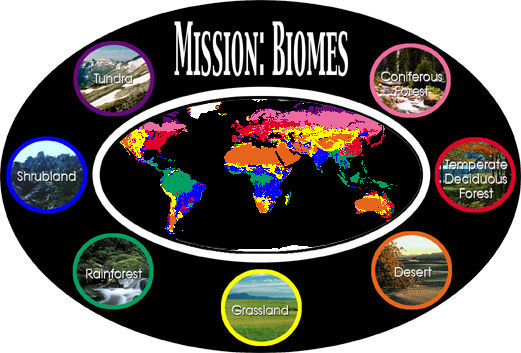
|
Biome - investigation |

Links: |
Biomes www.ucmp.berkeley.edu/exhibits/biomes/index.php The world's biomes 1. What are biomes? 2. How are they classified? 3. Is it possible for a biome to change? 4. Do you humans affect biomes? 5. What are the 6 major types of biomes? Conservation and preservation of biomes 6. Why is it important to preserve all types of biomes? 7. List 3 reasons why forests are important? 8. List a few reasons why the forests are being depleted 9. What are the 3 major types of forests? Click on forests Tropical 10. What are the characteristics of a tropical rainforest? 11. Based on these characteristics, why do you think the rain forest is a place of great vegetative life? Temperate 12. What are the characteristics of a temperate forest? Boreal forest (taiga) 13. What are the characteristics of a Boreal forest? 14. What is currently causing a threat to the Boreal forest? Click on freshwater 15. What is freshwater? 16. Can the organisms that live in a freshwater environment survive in salt water? 17. What are the 3 types of freshwater regions? Ponds and lakes 18. Compare the size of lakes and ponds. 19. Where can these bodies of water be found? 20. How do their characteristics affect which organisms live there? Streams and rivers 21. How do their characteristics affect which organisms live there? Wetlands 22. List examples of wetlands. 23. Why do wetlands have the highest species diversity of all ecosystems? Click on Marine 24. How much of the earth is covered by the marine biome? 25. List the 3 marine biomes. 26. What is a major importance of the Marine biome in terms of gas exchange? 27. What is a major importance of the marine biome in terms of the hydrolytic (water) cycle? Oceans 28. What is the largest ecosystem? 29. Each of the four zones have a great diversity of species. List the 4 ocean zones and one characteristic of each. Coral Reefs 30. Where are coral reefs found? 31. What organisms can be found living in a coral reef? Estuaries 32. What is an estuarie? 33. Why do estuaries have diverse life? Click on Desert 34. How much of the earth’s surface is covered by the desert biome? 35. Are all deserts hot? 36. Based on the desert climate, what type of organisms live there? 37. What are the 4 major types of deserts? Hot and dry desert 38. Describe the climate in a “hot & dry desert” 39. What adaptations do the plants of this biome exhibit? 40. What adaptations do the animals of this biome exhibit? Semiarid desert 41. Describe the climate in a “semiarid desert” 42. How have plants adapted to this biome? 43. How have animals adapted to this biome? Coastal desert 44. Describe the climate in a “coastal desert” 45. How have plants adapted to this biome? 46. How have animals adapted to life in this biome? Cold desert 47. Describe the climate in the “cold desert” 48. Describe how plants are adapted for life in this biome 49. Describe how animals are adapted for life in this biome Click on Grassland 50. What is the distinguishing characteristic of grasslands? 51. What are the 2 main types of grasslands? Savanna 52. What is the distinguishing characteristic of savannas? 53. Where can savannas be found? 54. Describe the climate of the savanna. 55. Describe the types of savannas. 56. What are some of the environmental concerns of savannas? Temperate grassland 57. What is the distinguishing characteristic of temperate grasslands? 58. Where are the temperate grasslands of America? 59. What is the climate in the temperate grasslands? 60. How does rainfall affect the vegetation of this region? 61. List some of the organisms that live in the temperate grassland biome. 62. What are the environmental concerns of temperate grassland? 63. Briefly describe the types of grasslands. Click on Tundra 65. How is the tundra different from all other biomes studied? Tundra is the coldest of all the biomes. 66. How would the Finnish people describe the tundra? Tundra comes from the Finnish word tunturi, meaning treeless plain 67. List the characteristics of the tundra 1. Extremely cold climate 2. Low biotic diversity 3. Simple vegetation structure 4. Limitation of drainage 5. Short season of growth and reproduction 6. Energy and nutrients in the form of dead organic material 7. Large population oscillations 68. What are the 2 types of tundra? Arctic & Alpine Arctic tundra 69. Where are both the arctic tundra & Santa found? 70. Even thought the growing season is only ___ to ___ days, with temperatures as low as___ in the winter to a blistering ___in the summer. There are actually___ varieties of flowers. 71. How are plants adapted the arctic tundra? 72. How are animals adapted for life in the arctic tundra? Alpine tundra 73. Where is the alpine tundra located? 74. Unlike the arctic tundra this biome has warmer temperatures and growing season of approximately ___ days. |